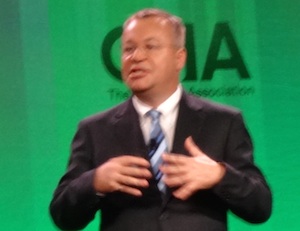
Suit, check. Hair cut, check. Mojo, oops.
You have to give Microsoft credit for trying. It was a distant third (or fourth or fifth or worse, depending on how you count) in the mobile operating system and smart phone races coming into the CTIA trade show in Las Vegas. No matter what happened, it wouldn’t narrow the gap significantly leaving it.
But if it ever wants to matter in the mobile world it has to start changing perceptions, and CTIA is a good place to begin. So when Stephen Elop took the keynote stage yesterday, a few short hours after Apple’s iPhone 6/Apple Watch extravaganza, he needed to demonstrate, by example, that Microsoft can make and sell things consumers or, indeed, anyone other than an IT professional, want.
He failed.
It’s hard not to look like a dweeb by comparison when you come on stage after an Apple mega-event, but Elop – Microsoft’s executive vice president in charge of devices, including Nokia products – would’ve done no better if he’d followed a Caterpillar tractor roll out.
His biggest clunker came while trying to explain Microsoft’s Digital Life positioning. The idea is to convince consumers to integrate Microsoft products and services into their daily, non-working lives like they have with iTunes and iPhones. The best example he could come up with was using Microsoft technology to have a “meeting” with a daughter who’s just gone off to college. At least he had the grace to look a little embarrassed and do the “air quotes” thing when he said “meeting”.
Microsoft has good products that fit well in an enterprise environment. Elop needed to explain why that’s a competitive advantage in the consumer world. He might have simply misread his audience: assumed he was talking to fellow IT guys rather than mobile execs who weave together phones, apps, content, services and networks into mass market selling propositions. Or it might just be the best Microsoft can do.
